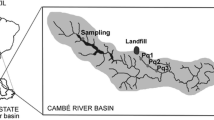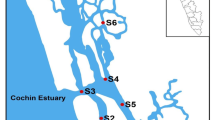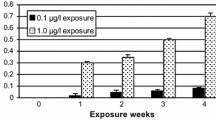Abstract
Dredged material management is a key issue for the protection of aquatic environments. The in situ approach using caged bioindicator species has been chosen lately as a new methodology for the assessment of dredged material. In a tier testing approach, neutral red retention (NRR) assay has been applied as a screening tool to detect adverse changes in health status associated with contamination. Nevertheless, to authors’ knowledge, little is known about the application and validation of this technique in sediment bioindicator species and under field conditions. Caged Ruditapes decussatus and Carcinus maenas were exposed during 28 days to potentially contaminated sediments at three sites in Algeciras Bay (SW Spain) and one site in Cádiz Bay (SW Spain). Lysosomal membrane stability was measured over time in haemolymph samples of exposed clams and crabs using the NRR assay. Sediment characterization of the study sites was performed in parallel. NRR time did not vary significantly (p > 0.05) over time in organisms from Cádiz Bay. Conversely, significant differences (p < 0.05) in NRR time were found in clams and crabs exposed to sediments from Algeciras Bay, which exhibited a 30–70% decrease in haemocyte lysosome membrane stability compared to day 0. Statistical analysis showed a strong correlation between the drop of haemocyte lysosome membrane stability, in both crabs and clams, and the presence of metals (p < 0.05) and PAHs (p < 0.01) in the studied sediments. The results obtained confirmed the use of NRR assay as a suitable and sensitive method to be used in the assessment of sediment quality using as bioindicator species the clam R. philippinarum and the crab C. maenas.



Similar content being viewed by others
References
Aarab N, Pampanin DM, Naevdal A, Oysaed KB, Gastaldi L, Bechmann RK (2008) Histopathology alterations and histochemistry measurements in mussel, Mytilus edulis collected offshore from an aluminium smelter industry (Norway). Mar Pollut Bull 57(6–12):569–574
Banni M, Bouraoui Z, Ghedira J, Clearandeau C, Jebali J, Boussetta H (2009) Seasonal variation of oxidative stress biomarkers in clams Ruditapes decussatus sampled from Tunisian coastal areas. Environ Monit Assess 155(1–4):119–128
Bebianno MJ, Barreira LA (2009) Polycyclic aromatic hydrocarbons concentrations and biomarker responses in the clam Ruditapes decussatus transplanted in the Ria Formosa lagoon. Ecotoxicol Environ Saf 72(7):1849–1860
Brown RJ, Galloway TS, Lowe D, Browne MA, Dissanayake A, Jones MB, Depledge MH (2004) Differential sensitivity of three marine invertebrates to copper assessed using multiple biomarkers. Aquat Toxicol 66(3):267–278
Casado-Martínez MC, Buceta JL, Belzunce MJ, DelValls TA (2006) Using sediment quality guidelines for dredged material management in commercial ports from Spain. Environ Int 32(3):388–396
CEDEX (Centro de Estudios y Experimentación de Obras Públicas) (1994) Recomendaciones para la gestión del material de dragado en los puertos Españoles. Puertos del Estado, Madrid
Cesar A, Choueri RB, Riba I, Morales-Caselles C, Pereira CDS, Santos AR, Abessa DMS, DelValls TA (2007) Comparative sediment quality assessment in different littoral ecosystems from Spain (Gulf of Cadiz) and Brazil (Santos and São Vicente estuarine system). Environ Int 33(4):429–435
Choueri RB, Cesar A, Abessa DMS, Torres RJ, Morais RD, Riba I, Pereira CDS, Nascimento MRL, Mozeto AA, DelValls TA (2009) Development of site-specific sediment quality guidelines for North and South Atlantic littoral zones: comparison against national and international sediment quality benchmarks. J Hazard Mater 170(1):320–331
Coughlan BM, Moroney GA, van Pelt FN, O’Brien NM, Davenport J, O’Halloran J (2009) The effects of salinity on the Manila clam (Ruditapes philippinarum) using the neutral red retention assay with adapted physiological saline solutions. Mar Pollut Bull 58(11):1680–1684
Dagnino A, Allen JI, Moore MN, Broeg K, Canesi L, Viarengo A (2007) Development of an expert system for the integration of biomarker responses in mussels into an animal health index. Biomarkers 12(2):155–172
DelValls TA, Andres A, Belzunce MJ, Buceta JL, Casado-Martinez MC, Castro R, Riba I, Viguri JR, Blasco J (2004) Chemical and ecotoxicological guidelines for managing disposal of dredged material. Trends Anal Chem 23:819–828
den Besten PJ, de Deckere E, Babut MP, Power B, DelValls TA, Zago C, Oen AMP, Heise S (2003) Biological effects-based sediment quality in Ecological Risk Assessment for European waters. J Soils Sediments 3(3):144–162
Fang JK, Wu RS, Zheng GJ, Lam PK, Shin PK (2010) Seasonality of bioaccumulation of trace organics and lysosomal integrity in green-lipped mussel Perna viridis. Sci Total Environ 408(6):1458–1465
Gorbi S, Virno Lamberti C, Notti A, Benedetti M, Fattorini D, Moltedo G, Regoli F (2008) An ecotoxicological protocol with caged mussels, Mytilus galloprovincialis, for monitoring the impact of an offshore platform in the Adriatic Sea. Mar Environ Res 65(1):34–49
Guerra-García JM, Baeza-Rojano E, Cabezas MP, Díaz-Pavón JJ, Pacios I, García-Gómez JC (2009) The amphipods Caprella penantis and Hyale schmidtii as biomonitors of trace metal contamination in intertidal ecosystems of Algeciras Bay, Southern Spain. Mar Pollut Bull 58(5):783–786
Handy RD, Galloway TS, Depledge MH (2003) A proposal for the use of biomarkers for the assessment of chronic pollution and in regulatory toxicology. Ecotoxicology 12(1–4):331–343
Hartwell SI, Hameedi MJ, Pait AS (2010) Empirical assessment of incorporating sediment quality triad data into a single index to distinguish dominant stressors between sites. Environ Monit Assess. doi:10.1007/s10661-010-1482-8
Jiménez-Tenorio N, Salamanca MJ, García-Luque E, González de Canales ML, DelValls TA (2008) Chronic bioassay in benthic fish for the assessment of the quality of sediments in different areas of the coast of Spain impacted by acute and chronic oil spills. Environ Toxicol 23(5):634–642
Langston WJ, Pope ND, Jonas PJ, Nikitic C, Field MD, Dowell B, Shillabeer N, Swarbrick RH, Brown AR (2010) Contaminants in fine sediments and their consequences for biota of the Severn Estuary. Mar Pollut Bull 61(1–3):68–82
Leotsinidis M, Sazakli E (2008) Evaluating contamination of dredges and disposal criteria in Greek coastal areas. Chemosphere 72:811–818
Liu G, Yang L, Fan T, Cong R, Tang Z, Sun W, Meng X, Zhu L (2006) Purification and characterization of phenoloxidase from crab Charybdis japonica. Fish Shellfish Immunol 20(1):47–57
Lowe DM, Pipe RK (1994) Contaminant induced lysosomal membrane damage in marine mussel digestive cells: an in vitro study. Aquat Toxicol 30:357–365
Lowe DM, Fossato VU, Depledge MH (1995) Contaminant-induced lysosomal membrane damage in blood cells of mussels Mytilus galloprovincialis from the Venice Lagoon: an in vitro study. Mar Ecol Prog Ser 129:189–196
Martín-Díaz ML, Blasco J, Sales D, DelValls TA (2007) Biomarkers study for sediment quality assessment in Spanish ports using the crab Carcinus maenas and the clam Ruditapes philippinarum. Arch Environ Contam Toxicol 53(1):66–76
Martín-Díaz ML, DelValls TA, Riba I, Blasco J (2008a) Integrative sediment quality assessment using a biomarker approach: review of 3 years of field research. Cell Biol Toxicol 6:513–526
Martín-Díaz ML, Jiménez-Tenorio N, Sales D, DelValls TA (2008b) Accumulation and histopathological damage in the clam Ruditapes philippinarum and the crab Carcinus maenas to assess sediment toxicity in Spanish ports. Chemosphere 71:1916–1927
Martín-Díaz ML, Sales D, DelValls A (2008c) Toxicokinetic approach for the assessment of endocrine disruption effects of contaminated dredged material using female Carcinus maenas. Ecotoxicology 17(6):495–503
Martín-Díaz ML, Blasco J, Sales D, DelValls TA (2009a) The use of a kinetic biomarker approach for in situ monitoring of littoral sediments using the crab Carcinus maenas. Environ Toxicol 23(5):643–651
Martín-Díaz ML, Franzellitti S, Buratti S, Valbonesi P, Capuzzo A, Fabbri E (2009b) Effects of environmental concentrations of the antiepilectic drug carbamazepine on biomarkers and cAMP-mediated cell signaling in the mussel Mytilus galloprovincialis. Aquat Toxicol 94(3):177–185
Martínez-Gómez C, Benedicto J, Campillo JA, Moore M (2008) Application and evaluation of the neutral red retention (NRR) assay for lysosomal stability in mussel populations along the Iberian Mediterranean coast. J Environ Monit 10(4):490–499
Martins LK, Nascimento IA, Fillmann G, King R, Evangelista AJ, Readman JW, Depledge MH (2005) Lysosomal responses as a diagnostic tool for the detection of chronic petroleum pollution at Todos os Santos Bay, Brazil. Environ Res 99(3):387–396
Matozzo V, Ballarin L, Pampanin DM, Marin MG (2001) Effects of copper and cadmium exposure on functional responses of hemocytes in the clam, Tapes philippinarum. Arch Environ Contam Toxicol 41(2):163–170
Morales-Caselles C, Martín-Díaz ML, Riba I, Sarasquete C, DelValls TA (2008a) The role of biomarkers to assess oil-contaminated sediment quality using toxicity tests with clams and crabs. Environ Toxicol Chem 27(6):1309–1316
Morales-Caselles C, Martín-Díaz ML, Riba I, Sarasquete C, DelValls TA (2008b) Sublethal responses in caged organisms exposed to sediments affected by oil spills. Chemosphere 72(5):819–825
Morales-Caselles C, Riba I, Sarasquete C, DelValls TA (2008c) The application of a weight of evidence approach to compare the quality of coastal sediments affected by acute (Prestige 2002) and chronic (Bay of Algeciras) oil spills. Environ Pollut 156(2):394–402
Munns WR Jr, Berry WJ, Dewitt TH (2002) Toxicity testing, risk assessment, and options for dredged material management. Mar Pollut Bull 44(4):294–302
Nigro M, Falleni A, Barga ID, Scarcelli V, Lucchesi P, Regoli F, Frenzilli G (2006) Cellular biomarkers for monitoring estuarine environments: transplanted versus native mussels. Aquat Toxicol 77(4):339–347
Petrović S, Ozretić B, Krajnović-Ozretić M, Bobinac D (2001) Lysosomal membrane stability and metallothioneins in digestive gland of mussels (Mytilus galloprovincialis Lam.) as biomarkers in a field study. Mar Pollut Bull 42(12):1373–1378
Pisoni M, Cogotzi L, Frigeri A, Corsi I, Bonacci S, Iacocca A, Lancini L, Mastrototaro F, Focardi S, Svelto M (2004) DNA adducts, benzo(a)pyrene monooxygenase activity, and lysosomal membrane stability in Mytilus galloprovincialis from different areas in Taranto coastal waters (Italy). Environ Res 96(2):163–175
Ramos-Gómez J (2011) Calidad del tejido biológico en organismos bentónicos afectados por vertidos marinos agudos y crónicos. Doctoral Thesis, Universidad de Cádiz
Ramos-Gómez J, Martín-Díaz ML, Rodríguez A, Riba I, DelValls TA (2008) In situ evaluation of sediment toxicity in Guadalete Estuary (SW Spain) after exposure of caged Arenicola marina. Environ Toxicol 23(5):643–651
Riba I, Forja JM, Gómez-Parra A, DelValls TA (2004) Sediment quality in littoral regions of the Gulf of Cádiz: a triad approach to address the influence of mining activities. Environ Pollut 132(2):341–353
Torres RJ, Abessa DMS, Santos FC, Maranho LA, Davanso MB, do Nascimento MRL, Mozeto AA (2009) Effects of dredging operations on sediment quality: contaminant mobilization in dredged sediments from the Port of Santos, SP, Brazil. J Soils Sediments 9:420–432
van der Oost R, Beyer J, Vermeulenc NPE (2003) Fish bioaccumulation and biomarkers in environmental risk assessment: a review. Environ Toxicol Pharmacol 13:57–149
Viarengo A, Lowe D, Bolognesi C, Fabbri E, Koehler A (2007) The use of biomarkers in biomonitoring: a 2-tier approach assessing the level of pollutant-induced stress syndrome in sentinel organisms. Comp Biochem Physiol C 146(3):281–300
Wedderburn J, Cheung V, Bamber S, Bloxham M, Depledge MH (1998) Biomarkers of biochemical and cellular stress in Carcinus maenas: an in situ field study. Mar Environ Res 46:321–324
Acknowledgments
This research was partially supported by different Research Projects funded by the Spanish Ministry of Science and Innovation (CTM2008-06344-C03-02/TECNO and CTM2008-06344-C03-03/TECNO). Sara Buratti was funded by Marco Polo mobility fellowship offered by Italian Government. Authors are grateful to Kiko and Rocío for their assistance in the field. Authors would like to thank Carmen Ramos and Robert Dunn for their selfless help in reviewing the English of the manuscript.
Author information
Authors and Affiliations
Corresponding author
Rights and permissions
About this article
Cite this article
Buratti, S., Ramos-Gómez, J., Fabbri, E. et al. Application of neutral red retention assay to caged clams (Ruditapes decussatus) and crabs (Carcinus maenas) in the assessment of dredged material. Ecotoxicology 21, 75–86 (2012). https://doi.org/10.1007/s10646-011-0767-1
Accepted:
Published:
Issue Date:
DOI: https://doi.org/10.1007/s10646-011-0767-1




